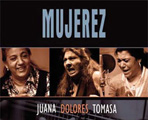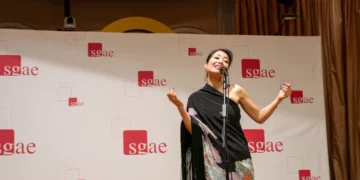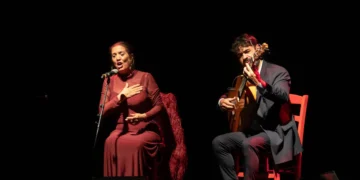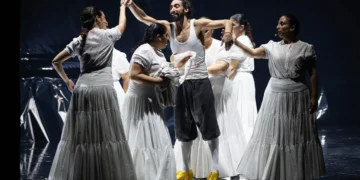Nowadays, when all things flamenco are touted as «innovative», «daring» or «fresh», it’s not easy to stand out from the crowd and catch people’s attention. A recording with the ingenious title «Mujerez» (the word can mean «women» or «very Jerez») has managed to spark the interest of flamenco lovers with a novel idea: classic cante with guitar. No cajón, and no click-track. Straight-ahead flamenco cante recorded live.
|
It’s a formula that gave good results for decades, when flamenco was the reserve of an elite minority, and the general public was more interested in popular Spanish music. Around the nineteen-seventies the revolution called Paco de Lucía and Camarón de la Isla burst on the scene, and overnight flamenco hit the charts of Spain’s top ten. Nothing wrong with that, but what no one could foresee, was the gradual disappearance of traditional cante from the commercial arena, including the recording market. If the first anthology of cante was recorded by the French, and Diego del Gastor was discovered by the Americans, once again it’s outsiders who have placed a high value on that which locals practically ignored. This is an admirable and welcome undertaking sponsored by BBK, a Basque banking concern, which for the second time in two years is supporting a production of this type. The earlier recording, “La Nueva Frontera del Cante de Jerez”, featured a group of young hopefuls, all male, giving them the chance to show what they could do. On this occasion, it is the ladies’ turn, not young hopefuls, but seasoned veteran singers.
1 Bulería para escuchar TE QUISE SIN DARME CUENTA Juana La del Pipa Moraito 06:25 |
Three great unmistakeable female voices: Juana la del Pipa, Dolores Agujetas and Tomasa la Macanita.
Juana Fernández de los Reyes, la del Pipa, was born six decades ago in the Santiago neighborhood of Jerez. She is incapable of singing a single line in a superficial way because of her thick raspy voice. Her cante benefits from the many years she has been singing for her nephew Antonio el Pipa, a circumstance that gives her the power to move freely through the compás or rhythmic structure. More than any other form, that which in Jerez is called “bulería pa escuchar”, and in other places is bulería por soleá, soleá por bulería or bulerías al golpe is, without a doubt, the cante that most defines Jerez, even more so than bulerías. In fact, it’s a cante which in this city has a well-defined identity other towns have not wanted to give it. Juana’s interpretation is rich and basic, somewhat aggressive, but hers is not a voice for dainty arabesques of melody.
Dolores de los Santos Bermúdez, “Dolores Agujetas” daughter of the great Manuel Agujetas, is another rough-hewn voice. On this recording she represents the San Miguel neighborhood with all the specific gravity implied. Possessing the unmistakable sound of her family, she perhaps tries a bit too hard, even imitating the voice of a little old lady, although her own is clean and natural. Nevertheless, we must value her contribution as faithful representation of a style of singing that is becoming more and more difficult to find. Recreating the subtly sharpened notes so ably managed by her father, she doesn’t quite control the technique and the resulting sourness may not be to everyone’s liking in the fandangos, especially the Torre style she uses to end, and the siguiriya of Manuel Molina. On the other hand, one must be grateful for the absence of digital manipulation normally applied nowadays to correct such things, all too often defusing the impact. Followers of the Agujetas line will not be disappointed, because Dolores holds nothing back. In the siguiriyas dedicated to “my father Agujeta”, she sings the styles her progenitor interprets, achieving some very good moments.
A feeling of fiesta and spontaneity giving life and credibility…qualities too often absent in current recordings.
Macanita, Tomasa Guerrero, the youngest of the three, is also the most professional and experienced, although in no way does this detract from the strength of her delivery. Many of us had expected more from that young girl with the warmly textured voice who appeared in Saura’s film “Flamenco” singing villancicos, but we mustn’t be greedy, the lady has found her path and earned a place of honor in the history of Jerez cante. The soleá is supported by Moraíto with an air of ‘soleá por bulería’, possibly at the singer’s request; she emulates the Utrera style of singing, a town where this cante is taken at a breezy clip. Singing some styles seldom heard in Jerez, she adds the characteristic energy of her hometown. This is a perfect example of the rich diversity flamenco affords when people put aside the militant localism that currently infects, and I do not mean “affects”, the genre.
There is an excellent round of tonás, the best proof that women can manage this difficult cante just as well as men. Each singer has her turn with bulerías. Dolores is reminiscent of Cristobalina from Lebrija, and her bulerías are well-varied; in general, each woman offers a separate and distinct personality. Malagueña and cante de Levante from Macanita, tientos by Juana…no one can complain about a limited repertoire. A feeling of fiesta and spontaneity is cultivated, giving life and credibility, values too often absent in current recordings.
The superb accompaniment of maestro Moraíto guarantees a Jerez feeling in the cantes of Juana and Tomasa, and Dieguito Agujetas does a fine job accompanying his mother Dolores on this record no flamenco fan can afford to pass up.
Manolo Caracol used to say, the three things a flamenco singer needs are “voice, voice and voice”. Here we have three magnificent ladies, with their pluses and minuses, three irresistible flamenco voices that will leave no one unmoved.
Descubre más desde Revista DeFlamenco.com
Suscríbete y recibe las últimas entradas en tu correo electrónico.




























